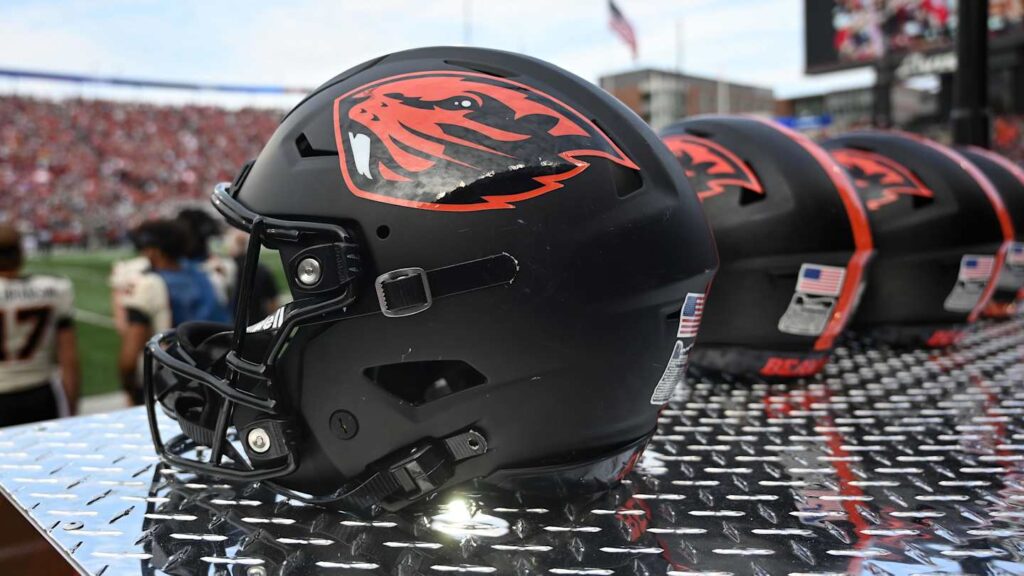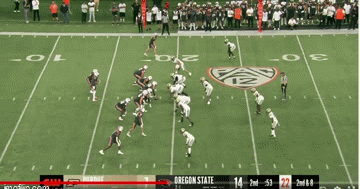Oregon State is hoping to help rebuild the Pac-12. Read more about OSU’s place in the college football landscape.
In the wake of the Pac-12’s mass exodus, Oregon State had to consider plenty of options for the future.
Oregon State athletic director Scott Barnes had previously said rebuilding the Pac-12 would be the program’s No. 1 choice. And now it appears that will happen with the addition of teams from the Mountain West.
Here’s more about where Oregon State fits in with college football’s conference realignment.
Boise State, Colorado State, Fresno State, and San Diego State have announced they are officially going to the Pac-12, beginning during the 2026 season.
Those moves will likely create a ripple effect for the rest of the FBS. The Pac-12 needs at least two more teams to be technically considered a conference, so others will likely become members of the new-look league. The Mountain West is losing some of its top teams and will probably begin searching for candidates to boost its numbers back up.
Pac-12 officials reportedly believe the league can reach a media deal worth more than the Mountain West’s currently, which could be a key reason for these moves.
The Pac-12 is no longer an autonomous league, meaning it had more influence in regards to NCAA decisions and received more money from the College Football Playoff. It’s uncertain if the Pac-12 could regain that status. It’s also unclear if the CFP would go back to six automatic qualifying spots for conference championship winners, as that number decreased to five following the Pac-12 dropping to two teams.
Utah State is reportedly going to be the fifth Mountain West team that is going to the Pac-12.
The Aggies have yet to publicly acknowledge the move, though lawsuit documents claim Utah State was allowed into the Pac-12, according to The Athletic.
It’s unclear how Utah State’s decision impacts other Mountain West teams. UNLV and Air Force were reportedly among the MW members to recommit to staying, but following news of USU’s move, leaders with those programs have reportedly begun to reconsider.
Several outlets published stories Tuesday about the Pac-12 filing a lawsuit against the Mountain West over its poaching penalties. That number will be more than $50 million depending on how many schools end up going from the Mountain West to the Pac-12.
Those fees are on top of the $17 million per school that the soon-to-be Pac-12 members will have to pay for leaving the Mountain West, though the Pac-12 will cover some or all of that.
The poaching penalties were part of the scheduling alliance that the Pac-12 and Mountain West made for this season.
The Pac-12’s argument is it’s an antitrust issue. The conference allegedly is claiming it had no choice but to agree to that deal because most of the conference’s teams had left and the league had only a few months to come up with a schedule for the 2024 season.
The Mountain West and Pac-12 didn’t sign off on a deal to continue their scheduling agreement past this season. The deadline to do so was Sept. 1.
Oregon State and Washington State made a scheduling deal with the Mountain West for this year. Mountain West teams scheduled seven games against league opponents with another being against either WSU or OSU in 2024. Those two programs aren’t eligible for the Mountain West Championship.
For one year of this arrangement, the two schools are paying the Mountain West $14 million, according to Yahoo Sports.
OSU and WSU previously took action which indicated the universities intended on seeing if they can keep the Pac-12 alive. And now the four Mountain West teams going to the Pac-12 reinforces that notion.
The presidents of Washington State and Oregon State make up the conference’s board of directors. That means those leaders alone have the power to decide what to do with the Pac-12 and its resources like TV revenue.
Those resources will help make it possible for the Pac-12 to add several new teams.
Per The Mercury News, Oregon State and Washington State were reportedly in discussions with multiple FBS conferences, both Power Four and Group of Five, about plans beyond this season. It appeared a move to a few conferences was possible.
But those talks also included more scheduling agreements and non-traditional arrangements, similar to the one the “Pac-2” has with the Mountain West this season.
The Mountain West was an obvious potential home for OSU and WSU if those two teams decided to completely dissolve what’s left of the Pac-12. The AAC also considered adding those two teams, but geography was the major factor why some sort of deal was not done.
If the Pac-12 is to survive, it needs to have at least eight total teams to meet the NCAA’s minimum.
The Pac-12 was reportedly hoping to add some of the top programs in the AAC as well, but now that’s not happening.
Memphis, Tulane, South Florida, and UTSA publicly announced a recommitment to the AAC on Monday. That seriously hampers the Pac-12’s expansion efforts.
All four of those schools are located in good markets, and all four of them were in bowl games in 2023. They were logical targets for the Pac-12 aside from travel costs.
Now the question is what other teams might the Pac-12 be considering, as the league needs two more new members to meet the NCAA’s requirements.
On the same day four AAC teams announced they wouldn’t be going anywhere, reports were made about Air Force staying put in the Mountain West.
Air Force was reportedly being considered as an addition for the AAC. Per ESPN, conversations between Air Force and the AAC were taking place before Boise State, Colorado State, Fresno State, and San Diego State announced they were going anywhere.
The move would’ve made sense for the Falcons. They could have joined a league with Army and Navy and could have avoided the uncertainty that the Mountain West is looking at. Air Force also doesn’t play too far from Denver, which provides some benefits as well.
Instead, the Falcons seem to be a part of the Mountain West’s immediate future.
It doesn’t seem likely Oregon State will go to the Big 12.
The Beavers might have several things going for their athletic department, but there hasn’t been much buzz about them joining the Big 12. And if that was a possibility, that likely would’ve happened by now.
OSU would make it 17 schools in the Big 12. Colorado, Arizona, Arizona State, and Utah are the previous Pac-12 members which are now in the Big 12 this year.
Oregon State doesn’t appear to be heading to the ACC, either. Cal, Stanford, and SMU are now in the ACC, however.
News likely would’ve leaked out from some source that Oregon State was in consideration among those schools.
USC, UCLA, Oregon, and Washington are the other previous Pac-12 schools which left, as they’re now in the Big Ten. Washington State and Oregon State are the only two Pac-12 schools which haven’t been heavily tied to another Power Four conference.
And the ACC isn’t in a stable place, either. Clemson and Florida State have both sued the ACC in recent months over matters related to the ACC’s grant of rights.
Neither school has given official notice that it intends to leave. However, Florida State has reportedly expressed frustration with the ACC’s media deal for months, saying FSU isn’t making enough to keep up with SEC and Big Ten programs seeking to win national championships.
For more Group of Five coverage, follow us on Facebook and Twitter.
The AAC was hoping to add Oregon State as it positions itself as the next “power” conference. But the American reportedly has stopped considering bringing in OSU and Washington State and added Army.
The AAC lost Houston, UCF, and Cincinnati to the Big 12 last year. But the league is hoping to be considered among the top college football conferences after adding UAB, UTSA, Charlotte, FAU, North Texas, and Rice in 2023.
The presidents of Sun Belt Conference schools reportedly met to go over potential plans by Oregon State and Washington State that would include a scheduling alliance between the Sun Belt and those two schools, according to Yahoo Sports.
However, those discussions were reportedly short. The Sun Belt’s leaders believed there was too much travel and not enough financial gain possible with an arrangement like that.
The College Football Playoff changed its format for 2024.
The CFP Board of Managers unanimously decided to alter the setup for the playoff. Now, the five highest-ranked conference title winners will automatically qualify, and the next seven highest-ranked teams will make up the rest of the field.
Previously, the six highest-ranked conference champions would make it. Then the next-highest ranked six teams would consist of the rest of the field.
“This is a very logical adjustment for the College Football Playoff based on the evolution of our conference structures since the board first adopted this new format in September 2022,” Mark Keenum, Mississippi State President and Chair of the CFP Board of Managers, said in a press release. “I know this change will also be well received by student-athletes, coaches and fans. We all will be pleased to see this new format come to life on the field this postseason.”
This year is the CFP’s first season of 12 teams making the playoffs.
Despite the 5+7 change, no specific conference will have an automatic qualifier, and there will be no maximum for a number of teams from any one conference.
With this new format, the five highest-ranked conference champions will automatically receive a CFP berth and the four highest-ranked conference title winners will have a bye during the first round. The next eight teams will be seeded Nos. 5-12, and the higher-seeded programs will host.
Then the quarterfinals and semifinals will be made up of the New Year’s Six bowls, and the national championship will keep being played at a neutral site.
Washington State and Oregon State, the two remaining Pac-12 teams in 2024, still can earn a spot in the CFP. However, that path will be difficult without a chance to automatically qualify with a conference championship.
Most of the Pac-12’s members are playing in other Power Four conferences this season. OSU and WSU agreed to a scheduling alliance with the Mountain West for 2024. Oregon State and Washington State won’t be eligible for the Mountain West’s conference title.
Oregon State has been a member of the Pac-12, though it has gone by different names, since 1964.
When OSU joined, it was known as the Athletic Association of Western Universities. Then the league became the Pacific-8 Conference in 1968 before being renamed the Pacific-10 Conference in 1978 when Arizona and Arizona State joined. It officially became the Pac-12 in 2011 after Colorado and Utah became members.
The Pac-12’s media deal with FOX and ESPN was reportedly worth $250 million per year and was set to expire this academic school year. The conference was seeking a new deal before several teams decided to leave.
The Mountain West agreed to a $270 million media rights deal in 2020 with CBS and FOX, according to The Athletic. That would mean teams are scheduled to be paid $4 million per year.
The arrangement would end after the 2025-26 season.
















































